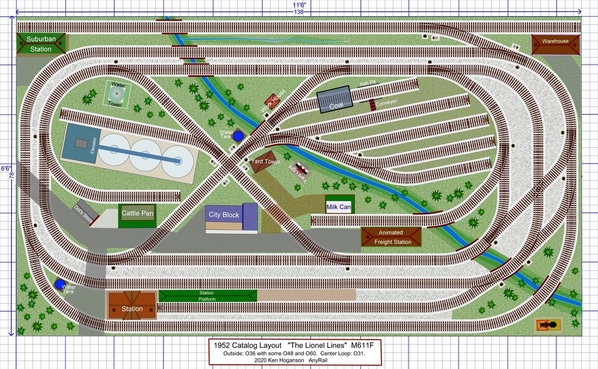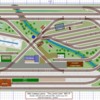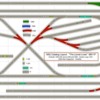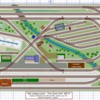Added FasTrack lighted switch stands, and block signals at the junction with the connecting RR at the top:
On this next version, I added a grade on the connecting RR going from right to left, with a wider lower level of older and dirtier ballast beneath.
Attachments
Trying out a colorized method to label track sections. Is this understandable, make sense? Its clearer if you click on it. -Ken
Seems to me its easy to read. The "compound curves" where I mixed diameter sections are immediately obvious.
To me it seems less visually confusing than the method where I label every track section. Here you can see what is going on without having to read labels, and when close together, figure out which label goes with which section. One can easily see the difference between a quarter/half/full curve section.
The green O60 turnouts come with roadbed trimmed sections, which I colored green to match the turnouts.
PLEASE CLICK LIKE ON THIS POST IF THIS SEEMS LIKE A GOOD IDEA. -THANKS!
Attachments
I have been watching and reading this for the past few days, and seen this evolve. I like a lot of it. Well done. A question I would ask is what kind of operating do you want to do? You have a lot of switches, are you looking to do a lot of switching operations or are you going to be a looper, watching your trains run around the tracks. My view is that if you are going to be a looper then all those extra switches just equal extra expense, and extra time for not a lot of real estate. Said another way - how many cars do you think you can store on those sidings? My guess is fewer than you think, and I ran into this same issue. I have two yards on my layout, and mostly they are used for on track storage as I am a looper.
John
Ken your efforts are amazing. The colored track is a bit easier to follow. But for perspective, can you post a 3D view of the latest iteration? I don't have AnyRail installed, I admit I'm very curious about its 3D capabilities. Thanks!!
@Ted S posted:Ken your efforts are amazing. The colored track is a bit easier to follow. But for perspective, can you post a 3D view of the latest iteration? I don't have AnyRail installed, I admit I'm very curious about its 3D capabilities. Thanks!!
Thanks Ted! Appreciate the feedback.
AnyRail is OK, but not strong, on 3D. I have posted 3D on a couple other layouts, but since this one is flat, it won't show much of interest.
-Ken
@jbmccormick posted:I have been watching and reading this for the past few days, and seen this evolve. I like a lot of it. Well done. A question I would ask is what kind of operating do you want to do? You have a lot of switches, are you looking to do a lot of switching operations or are you going to be a looper, watching your trains run around the tracks. My view is that if you are going to be a looper then all those extra switches just equal extra expense, and extra time for not a lot of real estate. Said another way - how many cars do you think you can store on those sidings? My guess is fewer than you think, and I ran into this same issue. I have two yards on my layout, and mostly they are used for on track storage as I am a looper.
John
Thanks so much, John!
Good point about the purpose of a model RR. When I work on a design, I try to incorporate as many good things of all types into a layout, but often with a theme.
This layout's them is to improve, enhance, and modernize a classic layout from '52. It is limited by the O31 minimum. I am trying to make the best I can, out of the signature aspects of the original layout, which I deem to be the interesting cross-overs between loops, and the space between the mainlines (which I made the most of with a passenger boarding track which is also a train staging track).
It doesn't have wide sweeping curves (nor did the original), but it does allow five trains on the layout, and a small yard. It doesn't have a big yard (the original had none), but it at least has a small one (11+ 10" cars). I can be fun for train running, with the inside figure-8, reverse loops, and the passing track, and multiple trains (not present in the original). One can do some switching operations, taking a small train out from the yard and servicing industries (not in the original). The layout does have a rational for passenger trains, and a place to stage one (or two, if using the Connecting RR, enhancements from the original).
Also, I realize that O gauge is expensive, and that each enthusiast will make their own decisions about what is worth adding a turnout for, and what they decide to skip. I show what can be done, then each person will customize as they see fit, and that is how it should be.
None of the turnouts are useless - perhaps the turnout in the upper right that extends the connecting RR, is the weakest function. Perhaps the next to go would be the turnout making the fifth short yard track. After that, eliminating a turnout eliminates a useful and important feature. The layout superintendent can make the decision about which feature they can live without.
Regards, Ken
Attachments
Ken,
I thought this was for you, your layout, hence my questions. Given your reply, I better understand what you are looking to do. This layout is similar to the one that I first made with two loops and a figure 8 in the middle for reversing action. I had some extra switches and so I was able to see how short the yards were going to be - holding 1-2 cars max before buying more.
John













